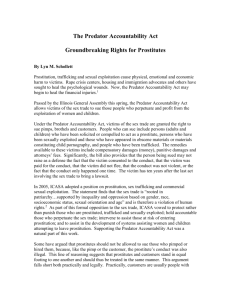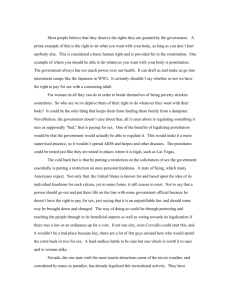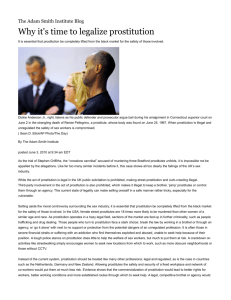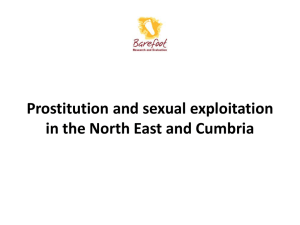Fallen No Longer: A Review Essay on the Historiography of
advertisement
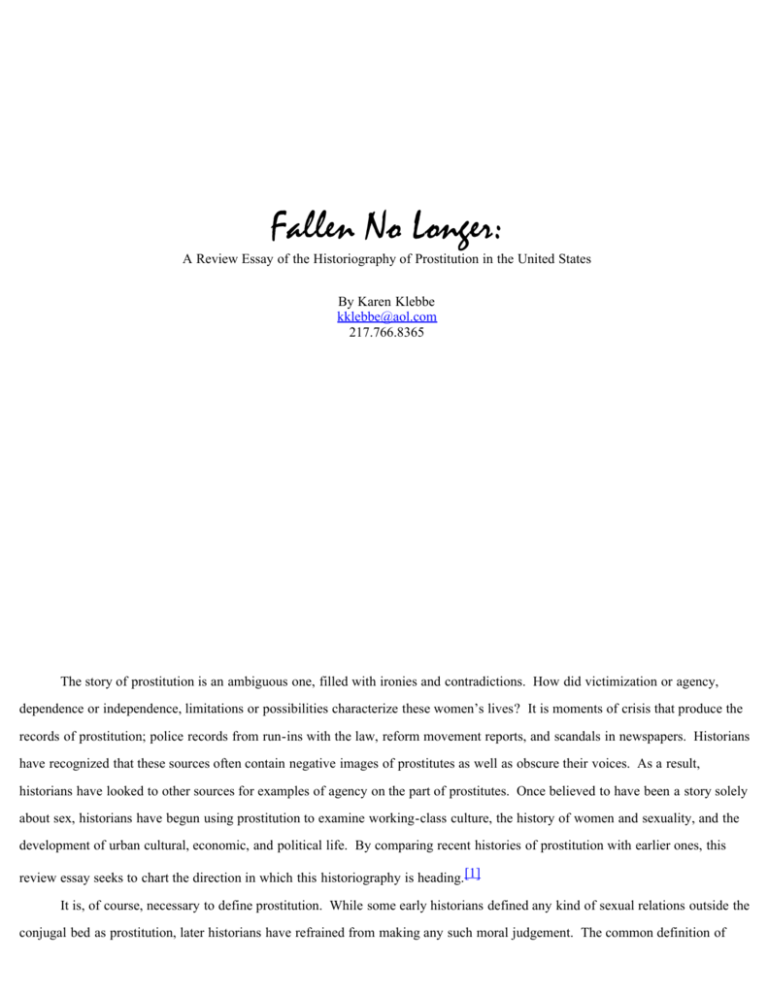
Fallen No Longer: A Review Essay of the Historiography of Prostitution in the United States By Karen Klebbe kklebbe@aol.com 217.766.8365 The story of prostitution is an ambiguous one, filled with ironies and contradictions. How did victimization or agency, dependence or independence, limitations or possibilities characterize these women’s lives? It is moments of crisis that produce the records of prostitution; police records from run-ins with the law, reform movement reports, and scandals in newspapers. Historians have recognized that these sources often contain negative images of prostitutes as well as obscure their voices. As a result, historians have looked to other sources for examples of agency on the part of prostitutes. Once believed to have been a story solely about sex, historians have begun using prostitution to examine working-class culture, the history of women and sexuality, and the development of urban cultural, economic, and political life. By comparing recent histories of prostitution with earlier ones, this review essay seeks to chart the direction in which this historiography is heading.[1] It is, of course, necessary to define prostitution. While some early historians defined any kind of sexual relations outside the conjugal bed as prostitution, later historians have refrained from making any such moral judgement. The common definition of prostitute is one who habitually or sporadically has sexual relations for money. This definition does not include men or women engaged in “treating,” the granting of sexual favors (not always intercourse) in return for such “treats” as dinners, entertainment, or items for personal adornment. Occasionally, such practices have been referred to as “amateur” prostitution and believed to be preferable to men, as it was cheaper than visiting a professional prostitute and believed to put one at less of a risk for disease. Except in rare instances, the prostitute is assumed to be female. This is perhaps due to the covert and clandestine nature of male prostitution. George Ryley Scott, in his History of Prostitution (1936), claimed male prostitution to be as old as the female branch, just practiced more surreptitiously. Perhaps the attention given to female prostitution has overshadowed it. In City of Eros: New York City, Prostitution, and the Commercialization of Sex, 1790-1920 (1992), historian Timothy Gilfoyle presents the conviction of Peter Sewally as an example of male prostitution. Arrested in New York in 1836, the black Sewally was charged with grand larceny. It was neither his crime nor his race that drew the attention of the authorities, but the feminine attire he was wearing at the time. He adopted the alias of Mary Jones and lived in a Greene Street brothel, where he claimed to perform domestic tasks as well as greeting male patrons. Gilfoyle asserts that Sewally’s employment in the brothel most likely involved more than domestic tasks and greeting, revealing that certain forms of male prostitution were tolerated and even linked to the brothel subculture. Gilfoyle also offers as evidence the prosecution of brothels by several New York district attorneys for “harboring” young boys, presumably to prostitute them to male clients. The lack of attention historians give to male prostitution may be due to little information. Most historians of prostitution rely substantially on court records for information, as it is usually only when a prostitute was arrested that any evidence of her existence was produced. With the examination of nineteenth-century court records involving sodomy charges, some historians have concluded that homosexuality was not perceived as a threat to the family in the same manner as female prostitution. Homosexuality, as we define it today, was not perceived as sexuality, identity, or a social problem in the nineteenth-century. This could account for the lesser interest in male prostitution. Though professed to be the “world’s oldest profession,” prostitution was not always an urgent social problem. In the early colonial period, the shortage of women and the desperate need for domestic labor guaranteed most women economic security as well as the protection of family and community. That the colonies were largely rural and agrarian also stymied the growth of a professional class of prostitutes. Religious leaders were more concerned with adultery and fornication outside of marriage than the exchange of sex for money. As Ruth Rosen, in The Lost Sisterhood: Prostitution in America, 1900-1918 (1982), suggests, prostitution was a temporary state of sin, a personal vice, rather than an occupation or status. This began to change with the industrialization and urbanization of America in the 1820s, starting in New England and the Mid-Atlantic States. The majority of early factory workers were young and unmarried females relocated from rural settings. In addition to being difficult, early factory work was low paying, often below starvation wages for women. Some young women resorted to prostitution in order to supplement their meager wages. In the growing metropolitan areas, there was a large unmarried and transient male population. Here the prostitute also found a large class of customers in newly arrived immigrants, as shown in Vern Bullough and Bonnie Bullough’s Women and Prostitution: A Social History (1987). As more women poured into urban areas, the economy of industrialization did not expand fast enough to provide them with stable high paying work. The few occupations open to women became oversaturated, consistently keeping the wages low. Nickie Roberts in her work, Whores in History (1992), shows how these economic conditions were the basis of an unprecedented boom in prostitution in the nineteenth-century. It was this boom in prostitution that caused Dr. William Sanger to survey 2,000 prostitutes in 1855 (see his History of Prostitution, rev. ed., 1919). Sanger was the resident physician of the penitentiary hospital on Blackwell’s Island in New York City, where patients were sentenced from the Court of Sessions or committed to the workhouse by police for vagrancy, drunkenness, or disorderly conduct. Not only did Sanger study prostitution all over the world from antiquity to the modern day, he questioned 2,000 New York female prostitutes on everything from their age, residency, and previous occupations to their marital status, number of children, and drinking habits. He classified the different kinds of prostitutes (mistress, brothel worker, women who worked out of a saloon or dance hall, and streetwalker) as well as the sites of prostitution, namely the parlor house, the brothel, the house of assignation, saloons, and the street. His general profile of a New York City prostitute is thus: young, foreign-born, unmarried, born one child, and from a poor working class family which had experienced some sort of economic/emotional trauma prior to her entrance to prostitution. Sanger also believed the prostitute spent on average only four years in the profession before succumbing to occupational hazards (alcoholism, syphilis) which resulted in her premature death. Marilynn Wood Hill, in Their Sisters’ Keepers: Prostitution in New York City, 1830-1870 (1993), argues that Sanger interpreted his results within a Victorian moralistic and middle class framework with certain biases against the culture of immigrants and the poor. Sanger’s finding that 62% of the prostitutes interviewed were foreign born did not necessarily correlate to the general population of prostitutes. He did not take into account the fact the pool of prostitutes from which he was extracting his information were all convicted, and discounted the possibility of foreign women being targeted more by police than their native counterparts. As Hill notes, immigrant women, often poor and less valued than native-born women, may have had trouble finding well paying jobs and resorted to prostitution more often than American-born women. When asked, “What was the cause of your becoming a prostitute?” over half the women surveyed replied inclination or destitution. By inclination, Sanger interpreted it to mean a voluntary resort in order to gratify the sexual passions and that these passions could only be awakened by some outside influence, be it the companionship of a prostitute or a member of the opposite sex. In a time when virtuous women were without passion or sexual desire, to concede sexual desire to prostitutes, Sanger implicitly labels them “deviant,” placing them in the category of “the other.” This plays into the representation of the prostitute as either the victim of seduction/abandonment, though only approximately 15% of those surveyed claimed this, or depraved. Yet Sanger does little analysis with the answer of destitution, other than acknowledge that working women’s wages were so low as to necessitate supplementing. Bullough and Bullough suggest that Sanger was using his study to bring about the regulation of prostitution in the United States with the purpose of preventing venereal disease. As Sanger notes, But if history proves that prostitution can not be suppressed, it also demonstrates that it can be regulated, and directed into channels where its most injurious results can be encountered, and its dangerous tendencies either entirely arrested or materially weakened.[2] Proposing the surveillance of registered prostitutes by a medical bureau to be established within the police department, prostitution’s most injurious results (i.e. syphilis) would be contained and prevented from contaminating innocent wives and children of men who consort with prostitutes. Sanger continues, If (a physician) were to pronounce a girl infected, the world has no security that she will not continue her avocation; in order to remove all doubt upon this question she should be instantly removed to an institution where she can not possibly propagate the malady. This must be done under conjoint medical and police authority.[3] Sanger advocates the incarceration of prostitutes (presumably against their will) in order to prevent the spread of disease to “innocents.” He claims that forcing a diseased woman to treatment in no way interferes with her personal liberty, comparing venereal disease to the spread of smallpox or yellow fever. The diseased prostitute’s freedom endangers every member of the community and is therefore a matter of public health. Attempts at regulation failed, primarily due to the opposition of newly organized women’s groups that claimed licensing was useless, as only a small percentage of prostitutes registered and men were not inspected. With the advent of the Progressive Era, the hey day of prostitution came to an end. Rosen notes that while Victorians considered prostitution to be a “necessary evil” that protected middle class women from the passions of men, and the prostitute to be a protector of domesticity, later prostitution became “the social evil,” a moral problem on a national level. While the social purity reforms resulted in the closing down of redlight districts in most American cities, prostitution did not disappear. It became more clandestine and went underground, taking the new forms of massage parlors and call girls. The control of prostitution shifted from the madams of the brothels and the prostitute herself to pimps and crime syndicates. In essence, the power and control of prostitution shifted to men. Almost seventy-five years after Sanger’s study the call for legalization and regulation of prostitution was still being heard. Another doctor, William J. Robinson, demanded that prostitution be declared legal, as it will always exist since it satisfies a definite and important biological need (see his The Oldest Profession in the World, 1929). Robinson cites five major reasons women become prostitutes (in order of importance): they are strongly sexed women, unable to find a husband/lover, homosexuals, poor/desirous of luxury, and/or have impotent husbands. With the recognition of active female sexuality during this time period, it is of little wonder Robinson, a sexologist, placed the female sex drive as the number one reason women went into prostitution. In fact, the female sex drive played a role in four out of the five reasons given. While not denying economic causes exist in the choice of prostitution for most women, Robinson cautions potential exaggeration of these causes. It is a love for luxury, desire for ease, and freedom from the shop, factory, or domestic service that inspires women to prostitution and not on-the-brink-of-starvation poverty. Robinson even becomes comical; suggesting it is women’s love of clothes (a “fact”) that cause even married women to enter into prostitution. The reasons men patronize prostitutes is just as comedic and almost three times as long, from man being naturally polygamous, to the ill-health of one’s wife, to sexual perversions. Robinson views the prostitute as providing a vital civic function. The prostitute makes monogamous marriage bearable for men, in that the variety she brings may inspire desire for one’s wife. The prostitute also make marriage bearable for the wife in that she protects the wife from her husband’s excessive virility and its potential violence should he not acquire satisfactory relief. For these and other reasons, prostitution should be made legal, judged as an occupation of public utility, and come under sanitary, not police, control. George Ryley Scott continued on in this vein with his work, A History of Prostitution from Antiquity to the Present Day. Arguing that the true cause of prostitution is the biological and physiological urge of virile men to have intercourse with a female, Scott finds men to be essentially polygamous. This results in the majority of men using prostitutes since few can afford multiple wives. What is interesting about Scott’s view of prostitution is that he unabashedly places the blame for prostitution on men, finding it Strange that…students of the subject should present as the major cause of prostitution the economic need of woman…The need for woman to earn a living outside orthodox respectable forms of labour, and of marriage, does not mean, as is so often submitted, that prostitution must exist. The real cause is the sexual appetite of man. This appetite creates the demand for fornication outside the married state; and the fact that man is willing to pay for the means of satisfying his sexual requirements bring into being the professional prostitute. [4] This is a view little explored by other early historians of prostitution. Scott believed that women entered into prostitution not out of an inability to find work, but because of a dissatisfaction with their station in life, prostitution could provide them with the funds to rise above their station. Scott attributes the decline of professional prostitution to the increased promiscuity found within the respectable (read middle) classes and the practice of “treating.” Scott does not predict that prostitution will die out; quite the opposite, it will forever exist in one form or another as long as men are willing to pay for their sexual satisfaction. The benchmark of recent scholarship on prostitution is Judith Walkowitz’s Prostitution and Victorian Society (1980), a study of the Contagious Disease Acts enacted in England in the 1860s. While a study in class and gender in mid-Victorian Britain, the controversy of the acts themselves generated massive documentation about the lives and actions of actors, such as prostitutes, largely missing from the larger historical narrative. Walkowitz opposes the portrayal of prostitutes as silent victims of social injustices and male oppression and instead claims them as important historical actors. Working-class women, Walkowitz finds, looked at prostitution as the best in a series of unattractive alternatives. These women were not without agency; they negotiated prices, exploited customers while being exploited, often controlled their own labor, and lived together as a distinct female subgroup within their own working class communities. From examining the registered prostitutes in Plymouth and Southampton, Walkowitz draws the conclusion that, since most women were in their early twenties, their experience of having previously been employed is likely, as is some kind of noncommercial sexual activity. The women also appeared to have left prostitution by their mid twenties, having only stayed in the profession for a few short years. Walkowitz finds this transition consistent with their working class counterparts as a time when most settled into a domestic situation with a man. It appears that as long as prostitution was a temporary period in a woman’s life, she was not forever stigmatized nor limited in her future choices. This finding is very different from Sanger, the nineteenth-century observer, and his belief that all prostitutes lived no more than four years after entering the profession (although one could see the two analyzing the same set of facts—a transitory community—and arriving at different conclusions/explanations). The workingclass fluid view of marriage and sexuality supported the community tolerance of prostitution. Many women lived out of wedlock with men, were married and deserted or practiced self-divorce. Prostitutes were also tolerated in the working class community because of the financial contribution these women made to their communities through exorbitant rents, dressmakers, hairdressers, washerwomen, and the like. Another incredibly influential work is Rosen’s The Lost Sisterhood. Rosen’s work examines the growth of urban prostitution, the reactions of a reform-obsessed society, and the progressive era legislation that resulted from this obsession. Like Walkowitz, Rosen believes focusing on a traditionally marginalized group brings the societal structure and cultural values of a society to light. The periodically uneasy truce between prostitution and society in the nineteenth-century ended as a result of forces that were transforming the societal order: urbanization, second wave immigration and industrialization, black migration to the northern cities, challenges to Victorian morality, and changes in family and class structure. The prostitute became a powerful symbol for these little understood socioeconomic issues. She explores the reformers’ massive publicizing of white slavery, and shows it to be more hysteria among the middle-class than a reality. Rosen concludes that white slavery stories were an acceptable form of pornographic entertainment as well as overshadowing the true social and economic reasons women ventured into prostitution. Rosen, like Walkowitz, argues that women entered into prostitution because they profited from prostitution, occasionally even achieving upward mobility. Prostitution was a microcosm of the greater society. Few reformers made the connection and viewed the subculture as the greatest social evil in America, a very top-down perspective. From the bottom up, however, prostitution offered an ugly and often times brutal, but nonetheless viable method of achieving the socially acceptable goal of material wealth in a society that became increasingly based on consumer culture. Compared to Walkowitz and Rosen’s groundbreaking work, Anne Butler almost takes a step backwards with her study of prostitution in the American West, Daughters of Joy, Sisters of Misery (1985). While Butler agrees that prostitution was a form of employment and prostitutes were not helpless victims, she does not completely accept prostitution as a deliberate career decision as do Walkowitz and Rosen. The post-Civil War frontier, with its overwhelmingly male population, created an atmosphere where prostitution could and did flourish in an open manner. Many women faced a particularly dismal economic situation as frontier work was mostly closed to them, there was a shortage of work, paltry wages, and inflated prices. According to Butler, these are the causes of frontier prostitution. The realistic economic gains of prostitution were marginal, as most of their clientele were fellow workers with little money. Poverty continually kept prostitutes at the margins. Butler also wishes to challenge the notion that the frontier welcomed prostitution in its infancy, only to reject prostitution as frontier society grew and became more stable. Her proof of this later rejection is the establishment of red-light districts in western cities and towns, which segregated prostitutes from the rest of society. Yet the evidence may suggest the opposite; that is the segregation of prostitution could be the acknowledgement of its place in society. This is an argument Butler does not explore. Prostitutes attempted to find security and stability in permanent relationships just like other women during the nineteenthcentury. Marriage and family life did not mandate retirement from the profession. Butler claims that the types of men prostitutes married, frequently saloon owners or pimps, brought violence and chaos to their lives, as it was expected that the women would continue to supplement the family income after marriage. Surprisingly, Butler herself imposes Victorian middle-class values on her subjects. She assumes that the women would have preferred to have ceased working and been in the home. Nor does she acknowledge that prostitutes may not have regarded their sexual services or the disorderliness of their lives as particularly unusual or undesirable. Prostitutes are poor mothers, she writes, since, Prostitution hardly encouraged the most admirable traits of motherhood. Only the strongest personality could have worked as a prostitute and still risen above the corruption, dissipation, and poverty of the profession to rear children in a balanced, stable home atmosphere. This did not happen, for prostitutes had neither the energy nor skills to overcome the social and economic stagnation that encompassed them and their children…the relationships that prostitutes maintained with their children, like those with their husbands, soured and warped all the participants.[5] There are no footnotes given for this kind of claim. She continually emphasizes scandalous stories of prostitutes’ alcoholism, fights with each other, and suicides as other examples of their “wretchedness.” By focusing on these particular aspects of the women’s lives, Butler fails to acknowledge the social context in which these women lived. In her attempt to demystify the image of the glamorous prostitute of the west with a heart of gold, she instead presents a pitiful victim who lacks the agency to change her “degraded” position. The Magdalenes: Prostitution in the 19th Century (1990), Linda Mahood’s look at Victorian Scottish prostitution through the medical profession, organized philanthropy, and the local state, has undoubtedly been influenced by Walkowitz and Rosen’s previous work. With the founding of Magdalene asylums and the lock hospital (the Glasgow system) in response to the Contagious Disease Acts of the 1860s in Great Britain transformed the structure of prostitution. The term prostitute appears continuously throughout the book in quotations as recognition of the fact it is a label dispensed by middle class observers and not an objective form of human behavior. Mahood’s study emphasizes women’s possibility of agency by concentrating on the form of resistance or acceptance of the moral code offered by the asylums and lock hospitals. Though not written by an academic historian, Whores in History bears mention, if for no other reason other than it was written by a former sex worker, Nickie Roberts. Roberts traces prostitution and women’s role in society from the Stone Age to our present day, using the word whore throughout, in an effort to reclaim it and defuse it of its pejorative overtones. While producing no new scholarship herself, Roberts freely admits to resting on the work of Walkowitz and Rosen, among others. She does do an excellent job of illustrating how the state itself pimps off the prostitute by creating a multitude of state employees- vice-squad cops, lawyers and judges, social workers, prison wardens and guards. Roberts puts prostitution on the feminist agenda by arguing that the whore stigma is the original tool of the patriarchy to oppress women, divide them from each other, and subordinate them to men. She writes, Uncomfortable as it may be for some feminists, though, it is implicit in the demand that women have control over their own bodies that they also have the right to sell their sexual services, if they wish to. There is no way that this can continue to be left off the feminist agenda; for what feminists and gays have been saying for twenty years now is that no one should have the right to legislate over the consensual sexual choices of other.[6] More than an economic choice, Roberts argues that prostitution is about retaining control over one’s sexuality. City of Eros (1992) and Their Sister’s Keepers (1993), written by Timothy Gilfoyle and Marilynn Wood Hill respectively, both cover nineteenth-century prostitution in New York City. Through analysis of real estate patterns of prostitution, the rise of an urban sporting male culture, and institutions of public leisure and commercial exchange, Gilfoyle identifies a three-part evolution of sex, from the sacred to the secular phenomenon, and back to the sacred. Gilfoyle also produces a historical cartography of New York’s commercial sex in the nineteenth-century by charting the changing geography of brothels. As a symbol of social degeneration for some and a public and popular activity for many, prostitution was highly ambiguous. It was not just sex for hire, according to Gilfoyle, but hotly contested cultural terrain. A certain paradox, prostitution represented the height of exploitation for women, yet rarely did other forms of labor offer such big financial gains. For men, it was a time of easy sexual exploration and freedom, but one that was inevitably linked to the limits of one’s financial resources. Gilfoyle ends by noting that the brothel declined due to a number of forces. The increase in “treating” and premarital sex made prostitution less necessary or attractive to single men. It was also cheaper. Further, as women made gains in the service sector and white collar jobs, their wages and working conditions increased, making prostitution less an economic necessity. In Their Sisters’ Keepers, Marilynn Wood Hill argues that the positive appeal and rewards of prostitution drew a variety of women into the profession. Whether as a temporary measure or long-term commitment, the financial rewards of prostitution were significant. However, Hill claims that beyond the reasonably comfortable standard of living, for many, the control of one’s own labor, and the support networks of other prostitutes and brothel madams offered significant, albeit less tangible, rewards. Hill uses numerous and varied sources for information, including census data, police and court documents, tax and property records, brothel directories, as well as the reports of reform organizations. Despite the litany of sources, it is Hill’s use of the personal letters of Helen Jewett, a popular prostitute in New York City during the 1830s, that is the most convincing of her argument that prostitutes enjoyed a broad range of positive human relationships. Jewett’s correspondence with friends and co-workers show these women supporting one another by sharing homes, leisure activities, visiting, money lending, and nursing in times of ill-health. Her correspondence with her customers is marked with affection rather than oppression. The letters appear more like those between lovers and not a prostitute and her customer. With examples of court cases, Hill, like Gilfoyle, demonstrates how prostitutes asserted their rights as citizens by suing customers, landlords, even each other. Hill focuses on brothel prostitutes, though this is most likely due to the sources available. Brothel prostitutes were more likely than streetwalkers to show up in censuses, tax records, and court cases. Hill urges the need to view prostitutes as people involved in the fullest range of human relationships, plagued by problems but given opportunities as well related to their profession and their gender. While there is a good deal of work produced about nineteenth-century prostitution, the field is by no means satiated. There are few, if any, works solely devoted to the minority prostitute or the streetwalker. Much of this lack of scholarship is due to a deficiency in sources about these women, but there the challenge lies. These women certainly existed; the trick is to find them. Nor has prostitution, after the progressive era, been much addressed by historians. Using prostitution to look at the cultural, political, and economic life of the mid-to late-twentieth-century will be the next phase of scholarship in its history. Regarded by early nineteenth-century reformers as depraved women with character defects, historians increasingly see prostitutes not as “fallen” women. By focusing on the every-day lives of prostitutes and the social and economic forces affecting their behavior, recent studies retrieve prostitution from the culture of depravity and crime. Believed to be a “necessary evil” by the Victorians, a “social evil” by the Progressives of the early twentieth-century, prostitution is today viewed by historians as a choice among few economic opportunities for poor and working-class women. Prostitution has become the perfect microhistory with which to study the structures of a society’s sexual, economic, and even political life. [7] No longer marginalized, historians now integrate prostitution into the larger historical narrative. [1] This essay reviews Vern Bullough and Bonnie Bullough, Women and Prostitution: A Social History, rev. ed. (Buffalo, NY, 1987); Anne Butler, Daughters of Joy, Sisters of Misery: Prostitutes in the American West, 1865-1890 (Urbana, IL., 1985); Timothy Gilfoyle, City of Eros: New York, Prostitution, and the Commercialization of Sex 1790-1920 (New York, 1992); and “Prostitutes in History: from Parables of Pornography to Metaphors of Modernity,” American Historical Review (Winter, 1999); Marilynn Wood Hill, Their Sisters’ Keepers: Prostitution in New York City 1830-1870 (Berkeley, CA., 1993); Linda Mahood, The Magdalenes: Prostitution in the 19th Century (London, 1990); Nickie Roberts, Whores in History: Prostitution in Western Society (London, 1992); William J. Robinson’s The Oldest Profession in the World (New York, 1929); Ruth Rosen, The Lost Sisterhood: Prostitution in America 1900-1918 (Baltimore, 1982); William Sanger’s The History of Prostitution, rev. ed. (New York, 1919); George Ryley Scott, A History of Prostitution from Antiquity to the Present Day (New York, 1936); and Judith Walkowitz, Prostitution and Victorian Society: Women, Class, and the State (Cambridge, 1980). [2] Sanger, The History of Prostitution, 20. [3] Ibid., 646. [4] Scott, A History of Prostitution, 20. [5] Butler, Daughters of Joy, 41. [6] Roberts, Whores in History, 355. [7] For a similar argument, see Timothy Gilfoyle’s American Historical Review article “Prostitutes in History: From Parables of Pornography to Metaphors of Modernity.”



